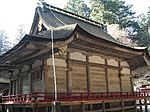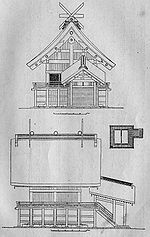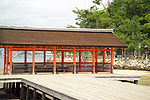List of National Treasures of Japan (shrines)
The number of
History
The practice of marking sacred areas began in Japan as early as the
Beginning in the mid-6th century, as Buddhism was brought to Japan from Baekje, new styles of shrine architecture were introduced; today's Shinto shrine blueprint is of Buddhist origin.[15] The concept of temples as a place of assembly was applied to shrines. Spaces for worship were added in the form of extended roofs or worship halls (haiden) in addition to the main hall (honden).[7] The following stylistic elements of Buddhist temple architecture were assimilated and applied to Japanese shrines: column-base stones,[nb 4] brackets, curved roofs, painted surfaces, metal ornaments, corridors and pagodas.[7][8][16]
At the end of the 8th century as architectural styles evolved, new elements were added as is evident in
The auxiliary Marōdo Shrine at
Statistics
The 42[nb 1][nb 2] entries in the list consist of the following: main halls (honden), combined structures of honden, haiden with or without an ai-no-ma or heiden in between, oratories (haiden), offering halls (heiden), corridors, gates, fences, purification halls and other halls that are related to a shrine.

| Prefecture | City | National Treasures |
|---|---|---|
| Hiroshima | Hatsukaichi
|
1[nb 1] |
| Kagawa | Sakaide | 1 |
| Kagoshima | Kirishima | 1 |
| Kumamoto | Hitoyoshi | 1[nb 2] |
| Kyoto | Kyoto
|
6 |
Uji
|
2 | |
Yawata
|
1 | |
| Miyagi | Sendai
|
1 |
| Nagano | Ōmachi | 1 |
| Nara | Nara
|
2 |
| Tenri | 1 | |
| Uda | 1 | |
| Okayama | Okayama
|
1 |
| Ōita | Usa | 1 |
| Osaka | Osaka
|
1 |
Sakai
|
1 | |
| Saitama | Kumagaya
|
1 |
| Shiga | Nagahama | 1 |
| Ryūō | 1 | |
| Yasu | 2 | |
Ōtsu
|
3 | |
| Shimane | Matsue
|
1 |
| Taisha | 1 | |
| Shizuoka | Shizuoka
|
1 |
| Tochigi | Nikkō
|
6 |
| Tottori | Misasa | 1 |
| Yamaguchi | Shimonoseki
|
1 |
| Period[nb 5] | National Treasures |
|---|---|
| Heian period | 2 |
| Kamakura period | 9[nb 1] |
| Muromachi period | 5 |
| Momoyama period
|
8[nb 2] |
| Edo period | 18 |
Usage
The table's columns (except for Remarks and Images) are sortable pressing the arrow symbols.
- Name: name of the structure as registered in the Database of National Cultural Properties[6][nb 1][nb 2]
- Shrine: name of the shrine in which the structure is located
- Remarks: architecture and general remarks including
- size measured in ken, or distance between pillars; "m×n" denotes the length (m) and width (n) of the structure, each measured in ken
- architectural style (zukuri) and type of roofing
- existence of bargeboards, forked roof finials (chigi), step canopies, etc
- size measured in
- Date: period and year of the last major reconstruction; The column entries sort by year. If only a period is known, they sort by the start year of that period.
- Location: "town-name prefecture-name"; The column entries sort as "prefecture-name town-name".
- Images: picture of the structure; If the image shows more than one structure, the respective structure is indicated by a blue rectangle.
Treasures
| Name | Shrine | Remarks | Date | Location | Image |
|---|---|---|---|---|---|
| Ōsaki Hachimangū (大崎八幡宮, Ōsaki Hachiman-gū)[nb 6][25] | Ōsaki Hachimangū | gongen style[ex 12] complex
|
Azuchi-Momoyama period , 1607
|
Sendai, Miyagi 38°16′21″N 140°50′42″E / 38.27250°N 140.84500°E
|
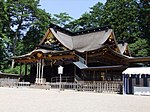
|
| Main Hall (本殿, honden), Room of Stone (石の間, ishi no ma) and Oratory (拝殿, haiden)[nb 7][31] | Tōshō-gū | irimoya style,[ex 8] front with a chidori hafu bargeboard[ex 10] and a 3 ken step canopy with a nokikarahafu gable.[ex 11] All three structures are single-storied and have copper-tile roofing. |
early Edo period, 1636 | Nikkō, Tochigi 36°45′29″N 139°35′55″E / 36.75806°N 139.59861°E
|

|
| Yōmeimon (陽明門)[nb 8][31] | Tōshō-gū | 3×2, two-storied sangen-ikko (三間一戸) gate in in every direction, copper-tile roofing, more than 500 carvings of historical anecdotes, children at play, wise men and others, connected to the Tōzai Kairō on either side | early Edo period, 1636 | Nikkō, Tochigi 36°45′28″N 139°35′55″E / 36.75778°N 139.59861°E
|

|
| Tōzai Kairō (東西廻廊)[31] | Tōshō-gū | 36 and 54 irimoya style[ex 8] with copper-tile roofing
|
early Edo period, 1636 | Nikkō, Tochigi 36°45′28″N 139°35′56″E / 36.75778°N 139.59889°E
|

|
| Karamon (唐門) (front and back)[31] | Tōshō-gū | 1×1, Chinese style gate decorated with white carvings, single-storied, with a karahafu style[ex 13] roof with copper-tile roofing, connected to the Tōzai Sukibei fence on either side | early Edo period, 1636 | Nikkō, Tochigi 36°45′29″N 139°35′55″E / 36.75806°N 139.59861°E
|

|
| Tōzai Sukibei (東西透塀) | Tōshō-gū | 43 and 44 ken long see-through fences extending to the east and west from the karamon , copper-tile roofing
|
early Edo period, 1636 | Nikkō, Tochigi 36°45′29″N 139°35′55″E / 36.75806°N 139.59861°E
|
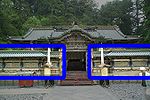
|
| Main Hall (本殿, honden), Middle Room (相の間, ai no ma), Oratory (拝殿, haiden)[nb 9] | Taiyuin Mausoleum (大猷院霊廟, taiyū-in reibyō) (Rinnō-ji )
|
irimoya style,[ex 8] front with a chidori hafu bargeboard[ex 10] and a 3 ken step canopy with a nokikarahafu gable.[ex 11] .
All three structures are single-storied and have copper-tile roofing. The shrine is the mausoleum of the third Tokugawa shōgun Tokugawa Iemitsu |
early Edo period, 1653 | Nikkō, Tochigi 36°45′28″N 139°35′39″E / 36.75778°N 139.59417°E
|

|
| Main Hall (本殿, honden) and inner gate (中門, chūmon)[33] | Nishina Shinmei Shrine | Honden: 3×2, oldest extant example of the shinmei style[ex 2]; Inner gate: four-legged gate |
middle Edo period, 1630 (inner gate) and 1636 (main hall) | Ōmachi, Nagano 36°27′00″N 137°52′44″E / 36.45000°N 137.87889°E | 
|
| Shōden Hall (聖天堂, shōden-dō)[6][37][38] | Kangi-in | Okuden (奥殿): 3×3, gongen style[ex 12] complex.
|
mid Edo period, 1744 (Okuden), 1756 (Haiden), 1760 (Chūden) | Kumagaya, Saitama
|
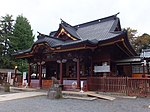
|
| Main Hall (本殿, honden), Room of Stone (石の間, ishi no ma) and Oratory (拝殿, haiden)[nb 10][39] | Kunōzan Tōshō-gū | Tokugawa Shogunate, Tokugawa Ieyasu and therefore the oldest of the Tōshō-gū shrines
|
Edo period, 1617 | Shizuoka, Shizuoka 34°57′53″N 138°28′03″E / 34.96472°N 138.46750°E
|
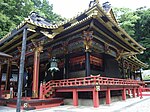
|
| Shinra Zenjin Hall (新羅善神堂, shinra zenjindō)[nb 11][40] | Mii-dera | 3×3, single-storied, ken step canopy, covered with hinoki cypress bark shingles. The structure houses the National Treasure Shinra Myōjin Zazō (新羅明神坐像), a sculpture of the deity that protects Mii-dera, Shinra Myōjin .
|
early Muromachi period, 1347 | 
| |
| Main Hall (本殿, honden)[nb 12] | Mikami Shrine | 3×3, single-storied, ken step canopy covered by hinoki cypress bark shingles
|
late Kamakura period | Yasu, Shiga 35°03′00″N 136°1′39″E / 35.05000°N 136.02750°E | 
|
| Main Hall (本殿, honden)[nb 13][41] | Ōsasahara Shrine | 3×3, single-storied, transom and doors
|
middle Muromachi period, 1414 | Yasu, Shiga 35°04′35″N 136°03′57″E / 35.07639°N 136.06583°E | 
|
| Main Hall (本殿, honden)[nb 6][42][43] | Tsukubusuma Shrine | 3×3, single-storied, ken, 60 decorative ceiling paintings of flowers in gold paint by Kanō Mitsunobu
|
Azuchi-Momoyama period , 1567 (step canopy and eaves) and 1602 (main building)
|
Nagahama, Shiga 35°25′15″N 136°8′39″E / 35.42083°N 136.14417°E | 
|
| West Hall of Worship (西本宮, nishi hon-gū), Main Hall (本殿, honden)[44][45] | Hiyoshi Taisha | 5×3, hiyoshi style[ex 7], hinoki cypress bark shingles | Azuchi-Momoyama period , 1586
|

| |
| East Hall of Worship (東本宮, higashi hon-gū), Main Hall (本殿, honden)[47] | Hiyoshi Taisha | 5×3, hiyoshi style,[ex 7] hinoki cypress bark shingles | Azuchi-Momoyama period , 1595
|

| |
| West Main Hall (西本殿, nishi honden)[nb 14] | Namura Shrine | 3 ken step canopy and hinoki cypress bark shingles
|
late Kamakura period, 1308 | Ryūō, Shiga 35°3′55″N 136°7′41″E / 35.06528°N 136.12806°E | 
|
| Main Hall (本殿, honden)[48][49] | Ujigami Shrine | 5×3, single-storied, flowing roof style[ex 5] with hinoki cypress bark shingles. The building consists of three single-ken shrines arranged side by side under the same roof. It is part of the World Heritage Site Historic Monuments of Ancient Kyoto (Kyoto, Uji and Otsu Cities) and the oldest extant main shrine building (honden). | late Heian period, 1060 | 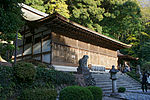
| |
| Oratory (拝殿, haiden)[nb 15] | Ujigami Shrine | 6×3, single-storied, ken step canopy and hinoki cypress bark shingles. The haiden is believed to have been originally constructed in the residential shinden-zukuri style. It is part of the World Heritage Site Historic Monuments of Ancient Kyoto (Kyoto, Uji and Otsu Cities) .
|
early Kamakura period | 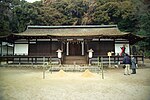
| |
| Iwashimizu Hachimangū main shrine 10 buildings (石清水八幡宮本社10棟, iwashimizu hachimangū honsha jūtō)[50][51][52] | Iwashimizu Hachimangū | irimoya style,.[ex 8] all structures with hinoki cypress bark shingles except for the Kairō, the east and west gates which have hongawarabuki roofing.[ex 17]
|
early Edo period, 1634 | Yawata, Kyoto 34°52′47″N 135°42′00″E / 34.87972°N 135.70000°E
|

|
| East Main Hall (東本殿, higashi honden) and West Main Hall (西本殿, nishi honden)[nb 16][49][53][45] | Kamomioya Shrine or Shimogamo Shrine | either hall: 3 ken wide flowing roof style,[ex 5] hinoki cypress bark shingles. founded before the Heian capital, present buildings from 17th century. They are part of the World Heritage Site Historic Monuments of Ancient Kyoto (Kyoto, Uji and Otsu Cities) .
|
end of Edo period, 1863 | Kyoto35°02′21″N 135°46′23″E / 35.03917°N 135.77306°E | 
|
| Main Hall (本殿, honden) and Associate Hall (権殿, gonden)[23][49][54] | Kamowakeikazuchi Shrine or Kamigamo Shrine | Both structures are identical in size and shape: 3×2, 5.9 m × 7.2 m (19 ft × 24 ft) flowing roof style[ex 5] with an extended roof in front to cover a prayer portico, hinoki cypress bark shingles. Honden and gonden were used alternatingly whenever one of them was being reconstructed or under repair. They are part of the World Heritage Site Historic Monuments of Ancient Kyoto (Kyoto, Uji and Otsu Cities). | end of Edo period, 1863 | Kyoto 35°03′38″N 135°45′10″E / 35.06056°N 135.75278°E | —
|
| Oratory (拝殿, haiden)[49][55][56] | Seiryōgū (清瀧宮) (Daigo-ji, upper Daigo (上醍醐)) | 7×3, overhang style (懸造, kake-zukuri), single-storied, ken step canopy and nokikarahafu gable.[ex 11] It is part of the World Heritage Site Historic Monuments of Ancient Kyoto (Kyoto, Uji and Otsu Cities) .
|
middle Muromachi period, 1434 | Kyoto 34°56′44″N 135°50′17″E / 34.94556°N 135.83806°E | 
|
| Karamon (唐門) | Toyokuni Shrine | four-legged gate irimoya style[ex 8] roof on the sides, covered with hinoki cypress bark shingles
|
Azuchi-Momoyama period , ca. 1598
|
Kyoto 34°59′30″N 135°46′19″E / 34.99167°N 135.77194°E | 
|
| Main Hall (本殿, honden), Room of Stone (石の間, ishi no ma), Oratory (拝殿, haiden) and Music Chamber (楽の間, gaku no ma)[nb 17][23][57] | Kitano Tenman-gū
|
irimoya style[ex 8] on one end, connected to the haiden, covered with hinoki cypress bark shingles complex. It was founded in the 10th century.
All four structures are single-storied. This is the oldest extant gongen style[ex 12] |
Azuchi-Momoyama period , 1607
|
Kyoto 35°01′53″N 135°44′06″E / 35.03139°N 135.73500°E | 
|
| Main Hall (本殿, honden)[58] | Yasaka Shrine | irimoya style[ex 8] with hinoki cypress bark roofing
|
early Edo period, 1654 | Kyoto 35°00′13″N 135°46′43″E / 35.00361°N 135.77861°E | 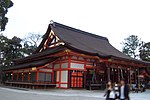
|
| Oratory (拝殿, haiden)[61] | Sakurai Shrine | 5×3, single-storied, (except for the rear step canopy) | late Kamakura period | Sakai, Osaka 34°29′07″N 135°30′23″E / 34.48528°N 135.50639°E
|

|
| Main Hall (本殿, honden)[nb 18][23][63] | Sumiyoshi Taisha
|
4×2, oldest example of the sumiyoshi style[ex 3] covered by hinoki cypress bark shingles. The shrine consists of four identical structures (positioned in "L"-shape), each 4.8 m × 8 m (16 ft × 26 ft). | late Edo period, 1810 | Osaka 34°36′45″N 135°29′35″E / 34.61250°N 135.49306°E | 
|
| Main Hall (本殿, honden)[65] | Uda Mikumari Shrine | three 1×1 kasuga style[ex 4] buildings with added hip rafter, covered with hinoki cypress bark shingles | late Kamakura period, 1320 | Uda, Nara 34°28′29″N 135°58′15″E / 34.47472°N 135.97083°E | 
|
| Main Hall (本殿, honden)[nb 19][23][67][68][69] | Kasuga Shrine
|
consists of four 1×1 shrine buildings 1.83 m × 2.64 m (6.0 ft × 8.7 ft) in kasuga style[ex 4] aligned in east–west direction on a grid frame, covered with hinoki cypress bark shingles; founded around mid 8th century, present form from beginning of Heian period, regularly demolished and reconstructed at 20-year intervals until 1863. It is part of the World Heritage Site Historic Monuments of Ancient Nara. | late Edo period, 1863 | 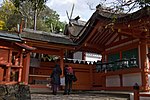
| |
| Oratory (拝殿, haiden)[70] | Sessha Izumo Takeo Shrine (摂社出雲建雄神社, sessha izumo takeo jinja) (Isonokami Shrine) | 5×1, single-storied, bark shingles | late Kamakura period, 1300 | Tenri, Nara 34°35′51″N 135°51′07″E / 34.59750°N 135.85194°E | 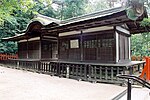
|
| Hakusan-dō (白山堂) and Kasuga-dō (春日堂)[nb 17][16][71] | Enjō-ji | two identical structures, each: 1×1, kasuga style[ex 4] with hinoki cypress bark shingles, together these are the oldest extant structures in the kasuga style | early Kamakura period, Antei era, 1227–1229 | 
| |
| Nageiri Hall (投入堂, nageiridō)[nb 20][72] | Okuno-in (奥院) (Sanbutsu-ji) | 1×2, single-storied, overhang style (懸造, kake-zukuri) with a flowing roof[ex 5] covered with hinoki cypress bark shingles | late Heian period | Misasa, Tottori 35°23′48″N 133°57′34″E / 35.39667°N 133.95944°E | 
|
| Main Hall (本殿, honden)[nb 21][23][73][74][75] | Izumo Taisha
|
2×2, taisha style[ex 1] with hinoki cypress bark shingles; 10.9 m × 10.9 m (36 ft × 36 ft) and 24 m (79 ft) high (originally 48 m (157 ft)), slightly curved roof, three ridge billets, believed to have been the house of Ōkuninushi | middle Edo period, 1744 | Taisha, Shimane 35°24′07″N 132°41′07″E / 35.40194°N 132.68528°E | 
|
| Main Hall (本殿, honden)[nb 22][76] | Kamosu Shrine | 2×2, taisha style[ex 1] with tochibuki board roofing[ex 19] | Azuchi-Momoyama period , 1583
|
Matsue, Shimane 35°25′32″N 133°05′03″E / 35.42556°N 133.08417°E
|

|
| Main Hall (本殿, honden) and Oratory (拝殿, haiden)[nb 23][23][79] | Kibitsu Shrine | kirizuma style,[ex 16] connected to the rear of the honden roof, pent roof on three sides covered with hongawarabuki roofing[ex 17] bark shingles. At 14.5 m × 17.9 m (48 ft × 59 ft), the largest shrine structure in Japan
Both structures are single-storied and covered with hinoki cypress |
middle Muromachi period, 1425 | Okayama 34°40′14.62″N 133°51′02″E / 34.6707278°N 133.85056°E | 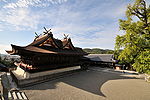
|
| main shrine: Main Hall (本殿, honden), Oratory (拝殿, haiden), Offering Hall (幣殿, heiden)[nb 1][nb 24][81][82][23][83] | Itsukushima Shrine | ryōnagare style[ex 21] Heiden: 1×1, ryōsage style[ex 9] |
early Kamakura period and late Muromachi period, 1241 (Heiden and Haiden), 1571 (Honden) | Hatsukaichi, Hiroshima 34°17′45″N 132°19′12″E / 34.29583°N 132.32000°E
|
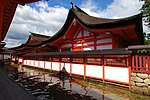
|
| main shrine: Purification Hall (祓殿, haraedono)[nb 1][nb 25][23][81] | Itsukushima Shrine | 6×3, single-storied, irimoya style,[ex 8] entrance in the gable ends, rear of roof is connected, hinoki cypress bark shingles. The shrine is a World Heritage Site .
|
early Kamakura period, 1241 | Hatsukaichi, Hiroshima 34°17′46″N 132°19′11″E / 34.29611°N 132.31972°E
|

|
| auxiliary Marōdo Shrine (Shrine for Guest Deities) (客神社, marōdo jinja): Main Hall (本殿, honden), Oratory (拝殿, haiden), Offering Hall (幣殿, heiden)[nb 1][nb 26][23][81] | Itsukushima Shrine | ryōnagare style[ex 21] Heiden: 1×1, ryōsage style[ex 9] |
early Kamakura period, 1241 | Hatsukaichi, Hiroshima 34°17′48″N 132°19′12″E / 34.29667°N 132.32000°E
|

|
| auxiliary Marōdo Shrine (Shrine for Guest Deities) (客神社, marōdo jinja): Purification Hall (祓殿, haraedono)[nb 1][23][81] | Itsukushima Shrine | 4×3, single-storied, irimoya style,[ex 8] entrances on the gable ends, at the back connected to the haiden roof, hinoki cypress bark shingles. The shrine is a World Heritage Site .
|
early Kamakura period, 1241 | Hatsukaichi, Hiroshima 34°17′47″N 132°19′12″E / 34.29639°N 132.32000°E
|

|
| East Corridor (東廻廊, higashi kairō)[nb 1][nb 27][23][81] | Itsukushima Shrine | 45 kirizuma style[ex 16] roof with hinoki cypress bark shingles. Extends from the entrance of Itsukushima Shrine past the Marōdo Shrine and the Asazaya to the purification hall of the main shrine. The shrine is a World Heritage Site .
|
era, 1558–1615 | Hatsukaichi, Hiroshima 34°17′46″N 132°19′13″E / 34.29611°N 132.32028°E
|

|
| West Corridor (西廻廊, nishi kairō)[nb 1][23][81] | Itsukushima Shrine | 62 kirizuma style[ex 16] gable at the eastern end and karahafu gable[ex 13] at the western end, covered with hinoki cypress bark shingles. The shrine is a World Heritage Site .
|
Azuchi-Momoyama period , 1563–1602
|
Hatsukaichi, Hiroshima 34°17′44″N 132°19′10″E / 34.29556°N 132.31944°E
|
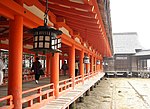
|
| Main Hall (本殿, honden)[nb 28][85] | Sumiyoshi Shrine
|
9 bay wide structure consisting of five concatenated buildings under a single flowing roof,[ex 5] covered with hinoki cypress bark shingles, the front roof has five dormers with chidori hafu bargeboards[ex 10]
|
early Muromachi period, 1370 | Shimonoseki, Yamaguchi 33°59′59″N 130°57′23″E / 33.99972°N 130.95639°E
|

|
| Main Hall (本殿, honden)[nb 17][86][87] | Kandani Shrine | 3×2, oldest extant example of the flowing roof style[ex 5] covered with hinoki cypress bark shingles | early Kamakura period, 1219 | Sakaide, Kagawa 34°19′29″N 133°55′00″E / 34.32472°N 133.91667°E | 
|
| Main Hall (本殿, honden)[nb 2][nb 29][89] | Aoi Aso Shrine | 3×2, flowing roof style[ex 5] with copper-tile roofing, connected to the south with the heiden via the corridor | Azuchi-Momoyama period , 1610
|
Hitoyoshi, Kumamoto 32°12′49″N 130°45′10″E / 32.21361°N 130.75278°E | —
|
| Corridor (廊, rō)[nb 2][89] | Aoi Aso Shrine | 1×1, single-storied, kirizuma style[ex 16] with copper-tile roofing, connects the honden in the north with the heiden in the south
|
Azuchi-Momoyama period , 1610
|
Hitoyoshi, Kumamoto 32°12′49″N 130°45′10″E / 32.21361°N 130.75278°E | —
|
| Offering Hall (幣殿, heiden)[nb 2][89] | Aoi Aso Shrine | 5×3, single-storied, roof | Azuchi-Momoyama period , 1610
|
Hitoyoshi, Kumamoto 32°12′48″N 130°45′10″E / 32.21333°N 130.75278°E | —
|
| Oratory (拝殿, haiden)[nb 2][89] | Aoi Aso Shrine | 7×3, single-storied, roof for the main building and copper-tile roof for the step canopy, connected in the north to the heiden | Azuchi-Momoyama period , 1611
|
Hitoyoshi, Kumamoto 32°12′48″N 130°45′11″E / 32.21333°N 130.75306°E | 
|
| Rōmon (楼門)[nb 2][89] | Aoi Aso Shrine | 3×2 two-storied gate with entrance through the central bay, roof | Azuchi-Momoyama period , 1613
|
Hitoyoshi, Kumamoto 32°12′47″N 130°45′11″E / 32.21306°N 130.75306°E | 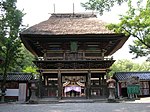
|
| Main Hall (本殿, honden), Offering Hall (幣殿, heiden), Oratory (拝殿, haiden)[91] | Kirishima-Jingū
|
ken step canopy; all with copper-tile roofing
|
mid Edo period, 1715 | Kirishima, Kagoshima 31°51′32″N 130°52′17″E / 31.85889°N 130.87139°E | 
|
| Main Hall (本殿, honden)[23][45][92][93] | Usa Shrine
|
ken step canopy.
|
late Edo period, 1855 | Usa, Ōita 33°31′24″N 131°22′38″E / 33.52333°N 131.37722°E | 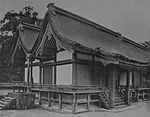
|
See also
- For an explanation of terms concerning Shinto, shrines and shrine architecture, see the glossary of Shinto.
Notes
Architecture
- ^
- ^
- ^
- ^
- ^
- ^ a b c (hachiman-zukuri, 八幡造): a style of shrine architecture characterised by a structure which appears from the side as two separate buildings with their gabled roofs joined by a rain gutter. The space between the buildings is enclosed and 1 ken wide. The entrances are in the center of each building on the side parallel to the ridges. The front structure is the outer sanctuary (外殿, gai-den), that at the rear the inner sanctuary (内殿, nai-den). Together they form the main hall (honden).[14][94]
- ^
- ^ irimoya-zukuri, 入母屋造): a hip-and-gable roof combining a ridge and two gable pediments on the upper part with a hipped roof on all sides in the lower part of the roof.[26]
- ^ a b c d e f g h i (ryōsage-zukuri, 両下造): a gable roof without gable pediments because other structures connect to it.[27]
- ^ a b c d e f g h (chidori hafu, 千鳥破風, lit. "plover gable"): a decorative dormer bargeboard on triangular shaped dormers with strong concave curves.[28]
- ^ a b c d e f g (nokikarahafu, 軒唐破風): an undulating Karahafu gable at eave ends.[29]
- ^
- ^ a b c d e (karahafu, 唐破風): an undulating bargeboard flowing downwards from the top center with convex curves on each side that change to concave curves which either level off or turn upward at the ends.[29]
- ken deep.[32]
- ^ a b (shikyakumon, 四脚門): a single-storied gate with two main pillars in line with the ridge of the roof and a pair of supporting square posts ("legs") on either side. Generally with a gabled roof.[35]
- ^ gabled roof with equal lengths from the ridge to the eaves.[36]
- ^ a b c (hongawarabuki, 本瓦葺): a tile roof composed of flat broad concave tiles and semi-cylindrical convex tiles covering the seams of the former.[62]
- ^ (tochibuki, 栩葺): type of board roofing whereby circa 1–3 cm (0.39–1.18 in) thick and 60 cm (24 in) long boards are split and laid down with considerable overlap.[14][78]
- irimoya-zukuri, 比翼入母屋造): a hip-and-gable roof exemplified by the one of Kibitsu Shrine with the main ridges of the roof parallel to the long side of the honden and ridges perpendicular to the main ridge creating two gables on each side of the ridge.[14][80]
- ^
- ^ yosemune-zukuri, 寄棟造): a hipped roof where the front and back are trapezoidal and the sides triangular in shape; in Japan generally used for buildings of less importance.[90]
General
- ^ a b c d e f g h i j k The National Treasure structures of Itsukushima Shrine are interconnected and registered as a single National Treasure under one registration number. Only in the main treasure table of this article, the single entry is split in parts for readability.
- ^ a b c d e f g h i j The National Treasure structures of Aoi Aso Shrine are registered as a single National Treasure under one registration number. Only in the main treasure table of this article, the single entry is split in parts for readability.
- ^ Presently only the Ise Grand Shrine is rebuilt every 20 years.
- ^ Before wooden columns were placed directly in the ground.
- ^ If a National Treasure was constructed during more than one period, only the oldest period is counted.
- ^ a b One munafuda (棟札) ridge tag with information on the building's construction is attached to the nomination.
- ^ The following items are attached to the nomination:
- bell house (鐘舎, shōsha),
- tōdaihoya (燈台穂屋) hut,
- sacred copper-plated storehouse (銅神庫, dōjinko),
- connection corridor (渡廊, watarō),
- gate of copper warehouse (銅庫門, dōko-mon),
- God's rest room (西浄, saijō),
- two iron fire baskets for lanterns (鉄燈籠),
- nine copper boxes with implements for the memorial service of the dead (銅箱入供養具),
- two side entrances (妻戸, tsumado),
- east passage gate (東通用御門, higashi tsuyōgō-mon) or 社家門 (shake-mon),
- 104 stone lanterns (石燈籠, ishitōrō),
- the road approaching the shrine (参道, sandō),
- emergency gate (非常門, hijō-mon)
- guard house (内番所, uchibansho)
- 16 copper fire baskets for lanterns (銅燈籠)
- one box of carpenter implements (箱入大工道具)
- one lamp stand (燈台)
- a stone fence,
- a torii.
- ^ Two former ceiling boards are attached to the nomination.
- ^ The following items are attached to the nomination:
- road from the Deva gate to the shrine,
- 66 copper fire baskets for lanterns,
- 249 stone lanterns,
- a stone fence,
- one miniature shrine,
- nine copper boxes with implements for the memorial service of the dead,
- one munafuda (棟札) ridge tag with information on the building's construction.
- ^ The following items are attached to the nomination:
- a set of eleven implements for the Anchin-hō ceremony of Esoteric Buddhism
- road approaching the shrine
- two copper lanterns
- a stone font for ritual cleansing
- one munafuda (棟札) ridge tag with information on the building's construction
- six two hanging lanterns
- a set of eleven implements for the Anchin-hō ceremony of
- ^ The nomination includes a dais and a miniature shrine.
- ^ Attached to the nomination is one miniature shrine.
- ^ Eleven munafuda (棟札) ridge tags with information on the building's construction are attached to the nomination.
- ^ One munafuda (棟札) ridge tag with information on the building's construction and one miniature shrine are attached to the nomination.
- ^ One frog leg strut (蟇股) and four sangarado (桟唐戸), panelled entrance doors, are attached to the nomination.
- ^ A total of eight subordinate shrine honden and a see-through fence are attached to the nomination.
- ^ a b c Six munafuda (棟札) ridge tags with information on the building's construction are attached to the nomination.
- ^ A mizugaki (瑞垣) fence with vertically set boards and a gate are included in the nomination.
- ^ The nomination includes a see-through fence, torii and a mizugaki (瑞垣) fence with vertically set boards.
- ^ The Aizen-dō (愛染堂) hall, 43 pieces of ancient lumber and one munafuda (棟札) ridge tag with information on the building's construction are attached to the nomination.
- ^ The nomination includes the inner shrine (内殿) and one munafuda (棟札) ridge tag with information on the building's construction.
- ^ The nomination includes an inner shrine and an ancient pillar called shin no mihashira (心御柱).
- ^ The nomination includes two munafuda (棟札) ridge tags with information on the building's construction.
- ^ The nomination includes the fence around the shrine and the left and right Naishi-bashi (内待橋), which are the bridges passed by women serving at the court (naishi) on their way to offer food for the gods.
- ^ The nomination includes:
- four munafuda (棟札) ridge tags with information on the building's construction,
- the High Stage (高舞台, takabutai) in front of the haraedono which is used for bugaku dance performances,
- the Open Stage (平舞台, hirabutai) in front of the main shrine,
- the left and right Kadomarōdo shrines (門客神社, kadomarōdojinja) located in front of the main shrine to either side of the hitasaki front lantern. The gate guards, toyoiwamado no kami (豊石窓神) and kushiiwamado no kami (櫛石窓神) are enshrined in them,
- the left and right gakubō (楽房) gagaku dance music halls in front of the main shrine, one for each type of gagaku dance: "left dance" from India and the Tang dynasty, "right dance" from China and Korea.
- ^ The nomination includes the fence around the shrine.
- ^ 19 munafuda (棟札) ridge tags with information on the building's construction are attached to the nomination.
- ^ Four munafuda (棟札) ridge tags with information on the building's construction and five miniature shrines (玉殿, gyokuden) are attached to the nomination.
- ^ One munafuda (棟札) ridge tag with information on the building's construction and five inscription boards (銘札) are attached to the nomination.
References
- ^ a b Kishida 2008, p. 34
- ^ Ono & Woodard 2004, pp. 26–27
- ISBN 0-415-05754-X. Retrieved 2009-11-01.
- ^ "Preservation and Utilization of Cultural Properties" (PDF). Administration of Cultural Affairs in Japan ― Fiscal 2009. Agency for Cultural Affairs. 2010. Archived from the original (PDF) on 2011-05-23. Retrieved 2011-05-08.
- ^ "Cultural Properties for Future Generations" (PDF). Tokyo, Japan: Agency for Cultural Affairs, Cultural Properties Department. March 2017. Archived from the original (PDF) on 2017-12-16. Retrieved 2017-12-17.
- ^ a b c d 国指定文化財 データベース [Database of National Cultural Properties] (in Japanese). Agency for Cultural Affairs. 2008-11-01. Retrieved 2009-04-16.
- ^ a b c d e f g h Young & Young 2007, p. 50
- ^ a b c d Fletcher & Cruickshank 1996, p. 724
- ^ a b Nishi & Hozumi 1996, p. 40
- ^ a b Kishida 2008, p. 33
- ^ Kishida 2008, p. 35
- ^ Kishida 2008, p. 126
- ^ Nishi & Hozumi 1996, p. 41
- ^ a b c d e f g h i j k l Kuroda 2005
- ^ Tamura 2000, p. 21
- ^ a b Nishi & Hozumi 1996, p. 43
- ^ Kishida 2008, pp. 40–41
- ^ Nishi & Hozumi 1996, p. 42
- ^ Kishida 2008, p. 127
- ^ Kishida 2008, pp. 42–43
- ^ Kishida 2008, pp. 128–129
- ^ Kishida 2008, pp. 43–44
- ^ a b c d e f g h i j k l m n Fletcher & Cruickshank 1996, p. 726
- ^ Kishida 2008, p. 131
- ^ "Ōsaki Hachiman Shrine – English information" (PDF). Ōsaki Hachimangū. Retrieved 2009-11-04.
- JAANUS – Japanese Architecture and Art Net User System. Retrieved 2009-11-08.
- JAANUS – Japanese Architecture and Art Net User System. Retrieved 2009-11-08.
- JAANUS – Japanese Architecture and Art Net User System. Retrieved 2009-11-08.
- ^ JAANUS – Japanese Architecture and Art Net User System. Retrieved 2009-11-08.
- JAANUS – Japanese Architecture and Art Net User System. Retrieved 2009-11-08.
- ^ a b c d 日光東照宮ホームページ [Nikkō Tōshō-gū homepage] (in Japanese). Tōshō-gū. Retrieved 2009-11-04.
- JAANUS – Japanese Architecture and Art Net User System. Retrieved 2009-11-08.
- ^ "大町市役所/国宝 仁 科神明宮" [Ōmachi public offic/ National Treasure Nishina Shinmei Shrine]. Ōmachi City. Archived from the original on 2011-06-05. Retrieved 2009-11-08.
- JAANUS – Japanese Architecture and Art Net User System. Retrieved 2009-11-08.
- JAANUS – Japanese Architecture and Art Net User System. Retrieved 2009-11-08.
- JAANUS – Japanese Architecture and Art Net User System. Retrieved 2009-11-08.
- Kumagaya city. 2012-07-09. Archived from the originalon 2012-09-11. Retrieved 2012-08-13.
- ^ 国宝・重要文化財(建造物)の指定について [Designation of National Treasures and Important Cultural Properties (buildings and structures)] (PDF) (in Japanese). Agency for Cultural Affairs. 2012-05-18. Archived from the original (PDF) on 2012-10-17. Retrieved 2012-08-13.
- ^ "境内案内" [Compound Guide]. Kunōzan Tōshō-gū. Archived from the original on 2011-02-04. Retrieved 2011-01-20.
- ^ "新羅善神堂" [Shinra Zenjin Hall]. Mii-dera. Retrieved 2009-11-08.
- ^ "大笹原神社本殿" [Ōsasahara Shrine main hall] (PDF). Shiga Prefecture. Archived from the original (PDF) on 2011-06-13. Retrieved 2009-11-08.
- ^ "竹生島神社" [Chikubushima Shrine]. Tsukubusuma Shrine. Retrieved 2009-11-08.
- ^ "竹生島 国 宝重要文化財" [Chikubushima National Treasures Important Cultural Properties]. Nagahama City. Archived from the original on 2013-04-15. Retrieved 2009-11-08.
- ^ "西本宮本殿" [West Hall of Worship main hall]. Hiyoshi Taisha. Archived from the original on 2008-10-19. Retrieved 2009-11-09.
- ^ a b c Kishida 2008, p. 42
- JAANUS – Japanese Architecture and Art Net User System. Retrieved 2009-11-09.
- ^ "東本宮本殿" [East Hall of Worship main hall]. Hiyoshi Taisha. Archived from the original on 2011-07-25. Retrieved 2009-11-09.
- ^ "Ujigami-jinja". Kyoto City. Retrieved 2009-11-09.
- ^ a b c d "Advisory body evaluation" (PDF). UNESCO. Retrieved 2009-11-09.
- ^ 国宝 新指定の部 [New designations of National Treasures] (PDF) (in Japanese). Agency for Cultural Affairs. 2015-10-16. Archived from the original (PDF) on 2016-03-16. Retrieved 2016-04-06.
- Asahi Shimbun. 2015-10-16. Archived from the original(PDF) on 2016-04-17. Retrieved 2016-04-06.
- Yawata city. 2015-10-16. Archived from the original(PDF) on 2016-03-07. Retrieved 2016-04-06.
- ^ "Shimogamo-jinja". Kyoto City. Retrieved 2009-11-09.
- ^ "Kamigamo-jinja". Kyoto City. Retrieved 2009-11-09.
- ^ "World Heritage Kyoto DAIGOJI Temple : Guide to Kami-Daigo (the upper part of Daigo)". Daigo-ji. Archived from the original on 2010-04-08. Retrieved 2009-11-09.
- ^ "Daigo-ji". Kyoto City. Retrieved 2009-11-09.
- Kitano Tenman-gū. Archived from the originalon 2011-05-09. Retrieved 2011-05-09.
- ^ "「八坂神社本殿」国宝指定について" [Yasaka Shrine Main Hall National Treasure designation]. Yasaka Shrine. Retrieved 2020-10-25.
- JAANUS – Japanese Architecture and Art Net User System. Retrieved 2020-10-25.
- JAANUS – Japanese Architecture and Art Net User System. Retrieved 2020-10-25.
- Sakai City. Archived from the originalon 2011-07-22. Retrieved 2009-11-09.
- JAANUS – Japanese Architecture and Art Net User System. Retrieved 2009-11-09.
- Sumiyoshi Taisha. Archived from the originalon 2010-07-03. Retrieved 2009-11-09.
- JAANUS – Japanese Architecture and Art Net User System. Retrieved 2009-11-09.
- ^ "本社本殿" [Main shrine main hall]. Uda Mikumari Shrine. Retrieved 2009-11-09.
- JAANUS – Japanese Architecture and Art Net User System. Retrieved 2009-11-09.
- Kasuga Shrine. Archived from the originalon 2019-06-18. Retrieved 2009-11-09.
- ^ "Nomination File". UNESCO. Archived from the original (PDF) on 2012-10-25. Retrieved 2009-11-09.
- ^ Kishida 2008, p. 41
- ^ "天理市ホームページ" [Tenri City homepage]. Tenri City. Archived from the original on 2012-12-19. Retrieved 2009-11-09.
- ^ "円成寺:鎮守社 春 日堂・白山堂" [Enjō-ji shrine Kasuga-dō, Hakusan-dō]. Naranet. Retrieved 2009-11-09.
- ^ "国宝 三 佛寺奥院『投入堂』" [National Treasure Sanbutsu-ji Okuno-in Nageiri Hall]. Sanbutsu-ji. Archived from the original on 2009-02-04. Retrieved 2009-11-09.
- ^ "The Architecture of Izumo Grand Shrine" (PDF). Shimane Prefecture. Archived from the original (PDF) on 2009-03-27. Retrieved 2009-11-09.
- Izumo Taisha. Archived from the originalon 2009-12-19. Retrieved 2009-11-09.
- ^ Kishida 2008, p. 36
- ^ "神魂神社" [Kamosu Shrine]. Kamosu Shrine. Retrieved 2009-11-04.
- JAANUS – Japanese Architecture and Art Net User System. Retrieved 2009-11-08.
- JAANUS – Japanese Architecture and Art Net User System. Retrieved 2009-11-09.
- ^ "国宝本殿拝殿" [National Treasure main hall, oratory]. Kibitsu Shrine. Archived from the original on 2011-08-23. Retrieved 2009-11-09.
- JAANUS – Japanese Architecture and Art Net User System. Retrieved 2009-11-09.
- ^ a b c d e f "Itsukushima Shrine". Miyajima Tourist Association. Retrieved 2009-11-10.
- ^ "Advisory body evaluation" (PDF). UNESCO. Retrieved 2009-11-09.
- ^ 広島県の文化財 – 厳島神社(本社,摂社客神社,廻廊) [Cultural Properties of Hiroshima Prefecture – Itsukushima Shrine (main shrine, auxiliary shrine, corridors)] (in Japanese). Hiroshima Prefecture. Archived from the original on 2009-12-10. Retrieved 2009-11-09.
- JAANUS – Japanese Architecture and Art Net User System. Retrieved 2009-11-08.
- Sumiyoshi Shrine. Archived from the originalon 2009-06-11. Retrieved 2009-11-04.
- ^ 国宝神谷神社本殿(坂出市の観光) [National Treasure Kandani Shrine main shrine (sightseeing in Sakaide)] (in Japanese). Sakaide City. Archived from the original on 2009-08-22. Retrieved 2009-11-04.
- JAANUS – Japanese Architecture and Art Net User System. Retrieved 2009-11-04.
- JAANUS – Japanese Architecture and Art Net User System. Retrieved 2009-11-04.
- ^ a b c d e 青井阿蘇神社 (in Japanese). Aoi Aso Shrine. Archived from the original on 2009-02-17. Retrieved 2009-11-10.
- JAANUS – Japanese Architecture and Art Net User System. Retrieved 2009-11-08.
- ^ 国宝 新指定の部 [New designations of National Treasures] (PDF) (in Japanese). Agency for Cultural Affairs. 2021-11-19. Retrieved 2021-11-19.
- Usa Shrine. Archived from the originalon 2010-03-29. Retrieved 2009-11-04.
- ^ 宇佐神宮本殿 [Usa Shrine Main Hall] (in Japanese). Bunka Oita. Archived from the original on 2011-07-22. Retrieved 2009-11-10.
- JAANUS – Japanese Architecture and Art Net User System. Retrieved 2009-11-08.
Bibliography
- ISBN 0-7506-2267-9. Retrieved 2009-11-11.
- Kishida, Hideto (2008). Japanese Architecture. READ BOOKS. ISBN 978-1-4437-7281-5. Retrieved 2009-11-11.
- Kuroda, Ryūji (2005-06-02). "History and Typology of Shrine Architecture". Encyclopedia of Shinto (β1.3 ed.). Tokyo: Kokugakuin University. Retrieved 2009-11-16.
- Nishi, Kazuo; Hozumi, Kazuo (1996) [1983]. What is Japanese architecture? (illustrated ed.). Kodansha International. ISBN 4-7700-1992-0. Retrieved 2009-11-11.
- Ono, Sokyo; Woodard, William P. (2004). Shinto the Kami Way (illustrated ed.). Tuttle Publishing. ISBN 0-8048-3557-8. Retrieved 2009-11-12.
- Tamura, Yoshiro (2000). "The Birth of the Japanese nation". Japanese Buddhism – A Cultural History (1st ed.). Tokyo: Kosei Publishing Company. ISBN 4-333-01684-3.
- Young, David; Young, Michiko (2007) [2004]. The art of Japanese architecture. Architecture and Interior Design (illustrated, revised ed.). Tuttle Publishing. ISBN 978-0-8048-3838-2. Retrieved 2009-11-11.
Further reading
- Cluzel, Jean-Sébastien (2008). Architecture éternelle du Japon - De l'histoire aux mythes (illustrated ed.). Editions Faton. ISBN 978-2-87844-107-9.
External links




